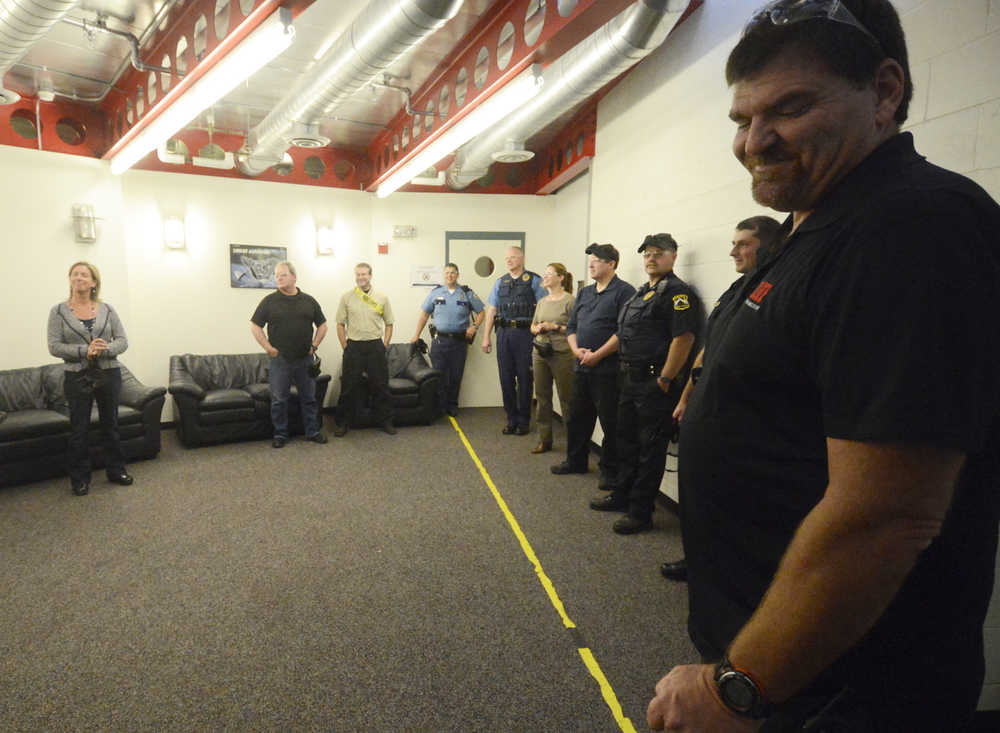Uniformed officers from law enforcement agencies throughout the Kenai Peninsula joined with Kenai Peninsula Borough School District administrators to learn about ALICE.
“Everybody’s here,” said Dave Jones, KPBSD assistant superintendent. “We’re getting on board together.”
ALICE, is an intruder response procedure that is drastically different than the traditional lockdown policy. ALICE, which stands for Alert, Lockdown, Inform, Counter, Evacuate, provides schools with options of how to best respond to a situation instead of drawing the blinds, locking the door and hiding.
Previously the school district did collaborate with law enforcement to a degree, but in working to implement ALICE in local schools, the agencies have ramped up efforts to work together.
“This is a really big step forward,” Jones said about increasing officer involvement in the school district.
Dallas Texas-based Greg Crane, former law enforcement officer, and his wife Lisa Crane, former school principal, created the program and came to Kenai last week to begin the process for implementing the procedure in the school district.
Principals from KPBSD schools attended training on Wednesday and local law enforcement officers completed a two-day train-the-trainer course. Greg Crane presented data and engaged course takers in simulations.
KPBSD Superintendent Dr. Steve Atwater said while the topic of armed intruder events is a difficult one, he said principals left their day of training feeling positive about ALICE.
Pegge Erkeneff, KPBSD spokesperson, said the training has been intense not only in adjusting to a different way of thinking about responding to a intruder situation, but also in recognizing the reality of the statistics.
“The fact is that in most lockdown situations the event is usually over before law enforcement gets there to save the day,” Erkeneff said. “It is very sobering.”
Kenai Police Department Lt. David Ross said the training takes a close look at intense situations that demonstrate the need for the district and law enforcement agencies to collaborate and make changes to the previous plan.
With so many different schools in the district — some with agencies nearby and others not as close — Ross said the training has provided a good chance to exchange ideas and safety options.
Jones said at schools fires are dealt with by the fire departments so it makes sense to involve officers to develop plans for with intruder situations.
On the final day of training officers and troopers were engaged in lockdown scenarios where two groups were asked to react to an armed shooter. The group was divided into two, and in the first scenario were asked to follow traditional lockdown methods, and in the second they had more freedom in using alternative ways of dealing with situation.
Alaska State Trooper Blake Calhoun acted as the shooter for the first scenario. He was handed an Airsoft gun, and was directed to shoot the “staff and students.” Greg Crane said this level of practice was not appropriate for younger trainees, and should only be used in teaching instructors.
“The (in-school) training will always be age appropriate,” Erkeneff.
When the two groups reconvened, Calhoun reflected that when entering the room where staff and students were only allowed to find refuge in the corners and behind furniture, it was like “shooting cattle.”
Greg Crane asked Calhoun if he had ever thought to make it easier on himself and walk inside the room, to which Calhoun had responded that it was easy enough from the doorway. Greg Crane said it is also unnatural for police officers to feel comfortable walking up to a target and shooting point-blank range.
Erkeneff said she had only observed lockdown drills and had never been engaged in one. She said she realized how non-compliant she felt with the current procedure and in reality would never feel comfortable sitting passively and not being more proactive in a lockdown situation.
Especially during the last four years law enforcement presence has increased in area schools, which helps officers to get to know staff, students and the building, Erkeneff said.
Prior to ALICE, schools didn’t have a “plan B” for intruder situations, this program allows for options, she said.
Jones said he likes that ALICE calls for real time alerts. Administrators can announce where in the building an intruder is which can allow for staff and students in another area of the school to evacuate if possible.
During the new few weeks, Erkeneff said administrators will be setting up ALICE training for staff and students at KPBSD schools and will be doing a lot of parent communication about the procedure.
The concept for ALICE began in 2001, Greg Crane said, and has since been implemented in more than 1,000 school districts across the country. In Alaska, the Matanuska-Susitna Borough and Valdez City school districts practicing ALICE procedures.
The U.S. Department of Homeland Security’s Run Hide Fight is a similar program that moves from encouraging being passive in intruder situations to being proactive. Similar to ALICE it allows for staff and students to choose how to best react in different scenarios. Jones said the district did look at that procedure as well as revising its lockdown strategy, but Run Hide Fight didn’t have as many response options as ALICE.
Erika Thompson, a teacher at the Whittier Community School, said any age group would be able to pull off barricading the doorways to prevent an intruder from entering the classroom, and even enjoyed trying to figure out the best furniture to use.
“Even if we practiced twice a year, or once a month, my students would be so dialed in on that,” Thompson said.
She said after even a few regular practices her students would be able to pull of the proactive lockdown methods like clockwork.
Kaylee Osowski can be reached at kaylee.osowski@peninsulaclarion.com.
Kelly Sullivan can be reached at kelly.sullivan@peninsulaclarion.com

